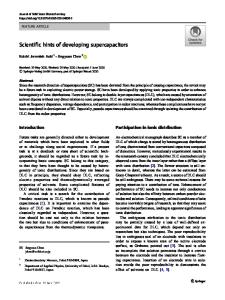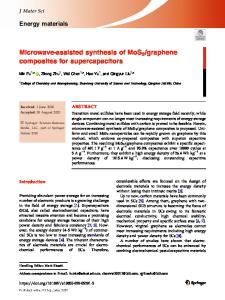Fiber Supercapacitors
Fiber supercapacitors have emerged as promising candidates to power the emerging wearable electronics in recent years because of their unique advantages in energy storage and mechanical flexibility. This chapter summarizes the development and applications
- PDF / 30,247,484 Bytes
- 470 Pages / 453.543 x 683.15 pts Page_size
- 35 Downloads / 340 Views
Fiber Electronics
Fiber Electronics
Huisheng Peng
Fiber Electronics
Huisheng Peng State Key Laboratory of Molecular Engineering of Polymers Department of Macromolecular Science and Laboratory of Advanced Materials Fudan University Shanghai, China
ISBN 978-981-15-9944-6 ISBN 978-981-15-9945-3 (eBook) https://doi.org/10.1007/978-981-15-9945-3 © The Editor(s) (if applicable) and The Author(s), under exclusive license to Springer Nature Singapore Pte Ltd. 2020 This work is subject to copyright. All rights are solely and exclusively licensed by the Publisher, whether the whole or part of the material is concerned, specifically the rights of translation, reprinting, reuse of illustrations, recitation, broadcasting, reproduction on microfilms or in any other physical way, and transmission or information storage and retrieval, electronic adaptation, computer software, or by similar or dissimilar methodology now known or hereafter developed. The use of general descriptive names, registered names, trademarks, service marks, etc. in this publication does not imply, even in the absence of a specific statement, that such names are exempt from the relevant protective laws and regulations and therefore free for general use. The publisher, the authors and the editors are safe to assume that the advice and information in this book are believed to be true and accurate at the date of publication. Neither the publisher nor the authors or the editors give a warranty, expressed or implied, with respect to the material contained herein or for any errors or omissions that may have been made. The publisher remains neutral with regard to jurisdictional claims in published maps and institutional affiliations. This Springer imprint is published by the registered company Springer Nature Singapore Pte Ltd. The registered company address is: 152 Beach Road, #21-01/04 Gateway East, Singapore 189721, Singapore
Preface
Fiber materials, including natural fibers discovered thousands of years ago and manmade fibers invented over a century ago, are indispensable for the basic life of humankind, as, for instance, they are woven into textiles to make us warm since ancient times. The resulting textiles also gradually become a key part of fashions, particularly in past centuries. Recently, fiber materials experience a revolutionary evolution to a new epoch with an electronic function based on the rapid advance of information technology and artificial intelligence. They may harvest energy, store energy, light, compute, communicate, and detect the environmental change both in vitro and in vivo, and many new electronic functions are further emerging for the fibers. A new direction or even a discipline, fiber electronics we previously named, has been thus generated from the above research. Fiber electronics that has been widely explored for a variety of applications ranging from power systems, information technology, artificial intelligence to public health has been attracting increasing interests since the past decade. More and more scientists and











